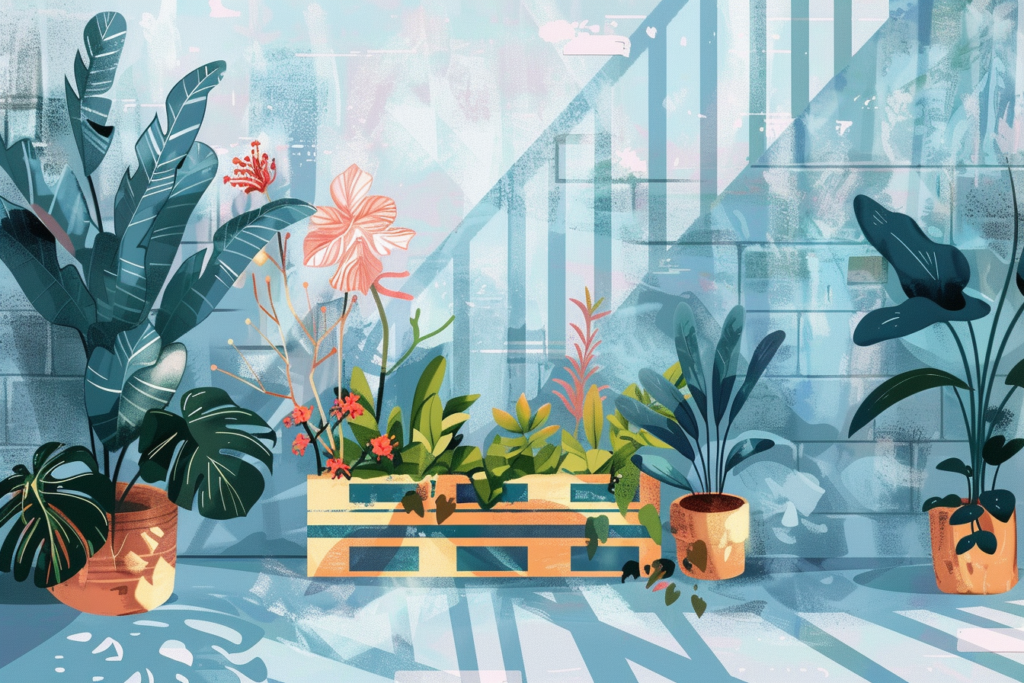Gardening has seen a resurgence in popularity as people seek to connect with nature and enhance their outdoor spaces. Pallet gardening stands out for its simplicity, cost-effectiveness, and aesthetic appeal among the many innovative gardening methods.
Using pallets to create a garden is a fantastic way to repurpose materials while creating a beautiful and functional space. We will walk you through the steps to create your own pallet garden.
Why Choose a Pallet Garden?
1. Cost-Effective
Local businesses often offer pallets for free or at a low cost, making them an affordable option for creating garden structures.
2. Space-Saving
Pallet gardens are ideal for small spaces like balconies, patios, or small yards. They can be positioned vertically, maximizing space usage.
3. Easy to Customize
Pallets are a blank canvas that can be stained, painted, stamped or left natural to match your outdoor decor. They can also be arranged in various configurations to suit your space and needs.
4. Eco-Friendly
Repurposing pallets reduces waste and promotes recycling, making it an environmentally friendly gardening option.
Materials and Tools Needed
Before you start your pallet garden, gather the following materials and tools:
- Wooden pallets (ensure they are safe for gardening by checking for any harmful chemical treatments)
- Landscape fabric or weed barrier
- Staple gun and staples
- Potting soil
- Plants or seeds
- Sandpaper
- Paint or wood stain (optional)
- Drill and screws (optional)
- Saw (optional)
Step-by-Step Instructions
Here are step-by-step instructions on how to create your dream pallet landscape.
1. Choose the Right Pallets
Not all pallets are suitable for gardening. Look for heat-treated pallets (marked with “HT”) rather than chemically treated. Avoid pallets with an “MB” stamp, which indicates they were treated with methyl bromide, a toxic chemical. Inspect the pallets, before buying them if you can, for any signs of damage, rot, or insects.
2. Clean and Prepare the Pallets
Once you’ve selected your pallets, clean them thoroughly to remove any dirt or debris. Use sandpaper to smooth any rough edges and surfaces to prevent splinters. If desired, then you can paint or stain the pallets and protect the wood from the elements.
3. Attach Landscape Fabric
To prevent soil from falling out and weeds from growing through, line the inside of the pallet with landscape fabric or a weed barrier. Cut the fabric (measure twice) to size and use a staple gun to secure it to the pallet’s back, sides, and bottom. Ensure the fabric is tight and covers all gaps.
4. Fill with Potting Soil
Lay the pallet flat on the ground with the fabric side facing down. Fill the pallet with potting soil, making sure to pack it firmly into each section. Use a high-quality potting mix suitable for the plants you plan to grow. Water the soil lightly to help it settle.
5. Plant Your Garden
Choose the best plants for your climate. Also, be conscious about where you place your pallet and how much sunlight your garden will receive. You can plant a variety of flowers, herbs, vegetables, or succulents. Create small holes in the soil and insert the plants or seeds. Be mindful of plant spacing and growth requirements.
6. Position the Pallet Garden
Carefully lift the pallet garden and position it in its designated spot. If placing the pallet vertically, ensure it is stable and secure. You can lean it against a wall or use brackets to fix it in place. If laying it flat, choose a level surface.
7. Water and Maintain
Water your pallet garden regularly, ensuring the soil stays moist but not waterlogged. The watering frequency will depend on the types of plants and the climate. Regularly check for pests and remove any weeds that may appear. Prune and harvest your plants as needed to promote healthy growth.
Tips for a Successful Pallet Garden

1. Choose the Right Plants
Consider your plants’ sunlight, water, and space requirements. Herbs, leafy greens, and succulents are excellent choices for pallet gardens. Avoid plants with deep root systems that may not thrive in the shallow soil of a pallet.
2. Soil Quality Matters
Invest in high-quality potting soil that provides good drainage and is rich in nutrients. This helps your plants grow healthy and strong.
3. Monitor Sunlight
Ensure your pallet garden receives adequate sunlight. Most plants require at least six hours of sunlight per day. Adjust the position of your pallet garden if necessary to optimize light exposure.
4. Regular Maintenance
Keep an eye on your garden’s moisture levels and water consistently. Deadhead flowers, prune plants, and remove any yellowing leaves to keep your garden looking its best.
5. Seasonal Adjustments
As seasons change, you may need to adjust your plant selections. Consider planting seasonal flowers and vegetables to keep your pallet garden vibrant throughout the year.
Creative Pallet Garden Ideas
1. Vertical Herb Garden
Plant a vertical herb garden with basil, rosemary, thyme, and mint. This is a practical and beautiful way to have fresh herbs at your fingertips.
2. Succulent Pallet Garden
Succulents are low-maintenance plants that thrive in pallet gardens. Arrange different varieties to create a stunning display of textures and colors.
3. Flower Wall
Transform a plain wall into a vibrant flower wall by planting a mix of colorful annuals and perennials. This adds a burst of color and life to your outdoor space.
4. Vegetable Pallet Garden
Grow your own vegetables in a pallet garden. Lettuce, spinach, radishes, and strawberries are excellent choices for pallet gardening.
5. Themed Gardens
Create themed pallet gardens, such as a butterfly garden with nectar-rich flowers or a sensory garden with plants that have interesting textures and scents.
Troubleshooting Common Issues
1. Soil Falling Out
Ensure the landscape fabric is securely attached and covers all gaps. Add more soil and pack it firmly to prevent it from falling out.
2. Poor Plant Growth
Check if your plants are receiving enough sunlight and water. Ensure the soil has proper drainage and is rich in nutrients.
3. Pest Infestation
Monitor your garden regularly for pests. Try natural remedies, such as, neem oil or insecticidal soap to control infestations.
4. Rotting Wood
If you notice the wood starting to rot, it may be due to excessive moisture. Ensure proper drainage and consider applying a wood sealant to protect the pallets.
Creating a pallet garden is a rewarding project that can transform your outdoor space into a lush green haven. With a little creativity and effort, you can enjoy the beauty and benefits of gardening, even in the smallest of spaces. Happy gardening!
You might also be interested in: 10 Low Maintenance Flowers And Bushes To Plant This Spring




